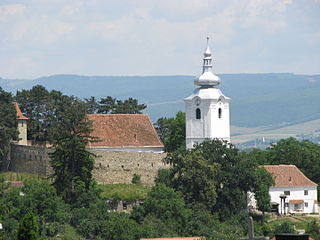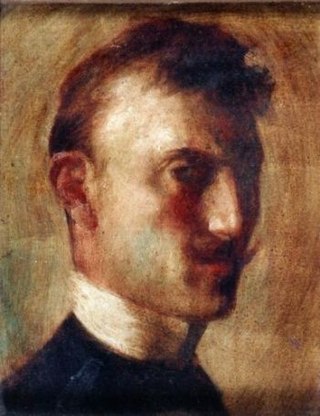Jenő Gyárfás (6 April 1857, in Sepsiszentgyörgy – 3 December 1925, in Sepsiszentgyörgy, renamed Sfântu Gheorghe) was a Hungarian portrait painter, graphic artist and writer.
Jenő Gyárfás (6 April 1857, in Sepsiszentgyörgy – 3 December 1925, in Sepsiszentgyörgy, renamed Sfântu Gheorghe) was a Hungarian portrait painter, graphic artist and writer.
From 1873 to 1877, he studied at the newly created Hungarian Royal Drawing School in Budapest, under the history painter Bertalan Székely. He continued his studies at the Academy of Fine Arts, Munich with Alexander von Wagner, Gabriel von Max and Wilhelm von Diez. [1]
He soon decided that he would like to specialize in paintings of figures and portraits, beginning with his fellow student, Bertalan Karlovszky. [1] His paintings of Vienna, Budapest and Munich were praised, but failed to attract buyers or patrons, so he supported himself by creating illustrations for the local magazines.
In 1882, he was awarded a state scholarship to study in Italy, but remained for only a short time, taking a position as an art teacher in Sepsiszentgyörgy. [1] Once there, he found himself isolated from all of the contemporary trends in painting, although he continued to do the same sort of work he had done in Munich. In 1896, as part of the "Hungarian Millennium Celebrations", he produced a canvas of King Ladislaus V, swearing an oath not to retaliate against László Hunyadi. [2]
He wrote odes, romances and ballads which he illustrated himself, although apparently none of them are currently available. [2] During this time, he also participated in illustrating The Austro-Hungarian Monarchy in Word and Picture , known as the "Kronprinzenwerk" for short; a 24-volume encyclopedia overseen by Crown Prince Rudolf. [1] He remained in his hometown after it became part of Romania in 1920, but his work suffered due to the effects of an eye disease and unspecified family problems. His former studio there now houses a small museum and exhibition hall, named after him.

Sfântu Gheorghe is a city that serves as the seat of Covasna County in Transylvania, Romania. Located in the central part of the country, it lies on the Olt River in a valley between the Baraolt Mountains and the Bodoc Mountains. The town administers two villages, Chilieni (Kilyén) and Coșeni (Szotyor).
Anton (Antal) Zilzer, was a Hungarian painter.

Mihály Zichy was a Hungarian painter and graphic artist. He is considered a notable representative of Hungarian romantic painting. He lived and worked primarily in St. Petersburg and Paris during his career.

Bertalan Székely was a Hungarian history and portrait painter who worked in the Romantic and Academic styles.

Bertalan Pór was a Hungarian painter associated with the development of modernist Hungarian art. He was a member of The Eight, a movement among several Hungarian painters in the early twentieth century who represented the radical edge in Budapest. They introduced Fauvism, cubism, and expressionism to Hungarian art.

Soma Orlai Petrich, aka Soma Orlay-Petrich was a Hungarian painter famous for his historical paintings and portraits.

János Thorma was a Hungarian painter. A representative figure of the Nagybánya artists' colony, which started in 1896, in Nagybánya, Austria-Hungary, he moved through different styles, shifted from the naturalism that was the aesthetic of the colony, to historical subjects, to romantic realism and to a Post-Impressionism style. His work is held by the Hungarian National Gallery, the Thorma János Múzeum, regional museums and private collectors.

István Réti was a Hungarian painter, professor, art historian and leading member, as well as a founder and theoretician, of the Nagybánya artists' colony, located in what is present-day Baia Mare, Romania. In addition, he served as president of the Hungarian University of Fine Arts (1927–1931) and (1932–1935).

Béla Iványi-Grünwald was a Hungarian painter, a leading member of the Nagybánya artists' colony and founder of the Kecskemét artists' colony.

Bertalan Karlovszky was a Hungarian painter.
József Koszta was a Hungarian painter whose major works include Girl with Geraniums, Corn Snappers and Woman Drying Plates.

Sándor Bihari was a Hungarian genre painter.

János Nagy Balogh was a Hungarian painter and graphic artist who specialized in proletarian subjects.

Géza László Udvary was a Hungarian painter in the Romantic style.

István Nagy was a Hungarian artist who specialized in landscapes and figure painting.

Fritz Schullerus was a Transylvanian Saxon painter.

Lajos Márk, also known as Louis Marc was a Hungarian painter, illustrator and poster artist.

Artúr Tölgyessy was a Hungarian landscape painter; specializing in scenes from the area around Lake Balaton.

Viktor Erdei, known as Győző Epstein until 1906 was a Hungarian sculptor, graphic artist and painter. He was the husband of Frigyes Karinthy's sister, the painter Ada Karinthy.